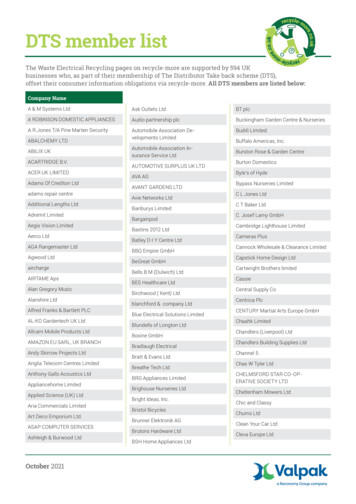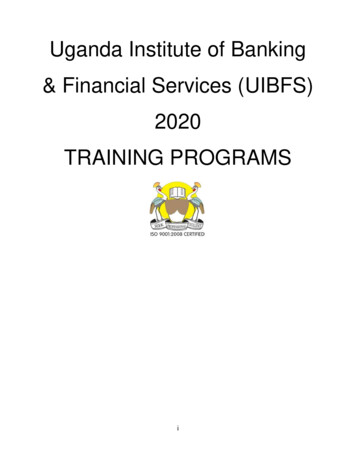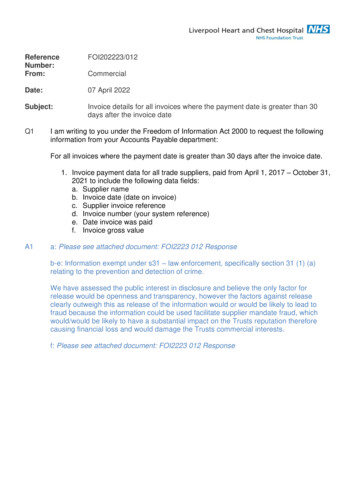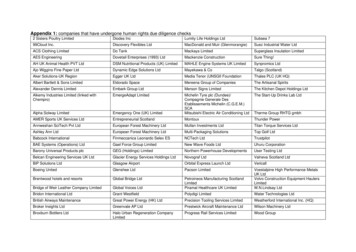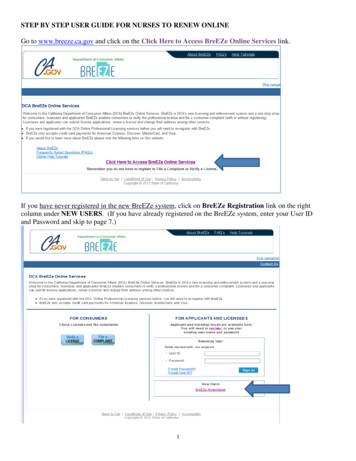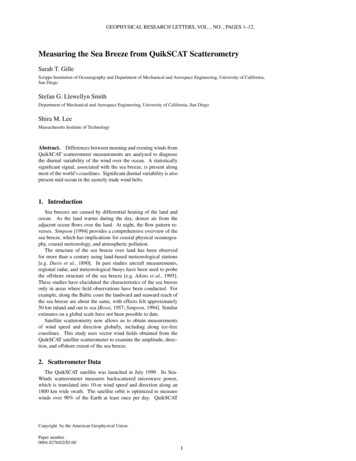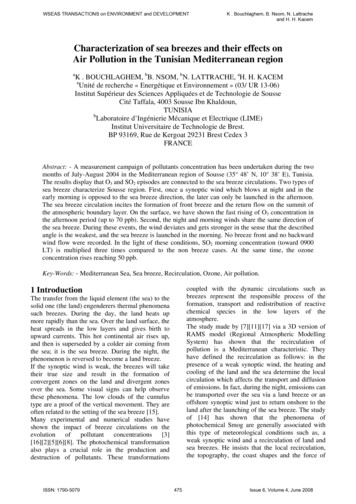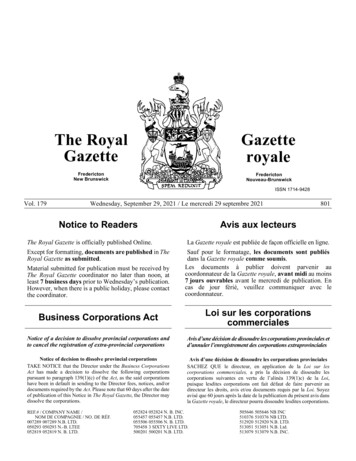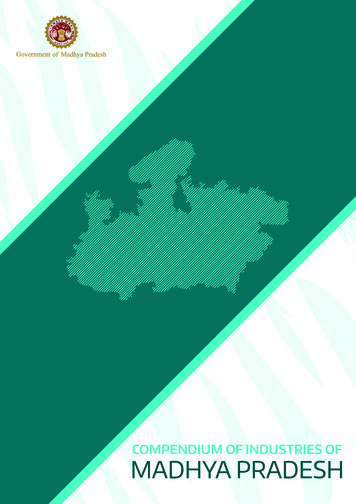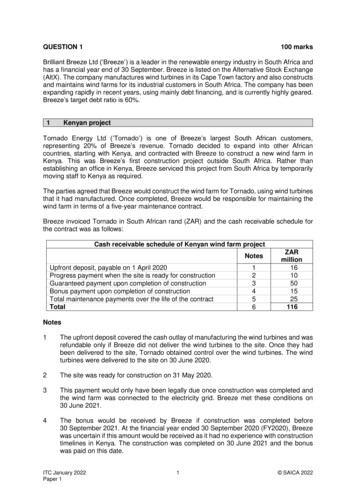
Transcription
QUESTION 1100 marksBrilliant Breeze Ltd (‘Breeze’) is a leader in the renewable energy industry in South Africa andhas a financial year end of 30 September. Breeze is listed on the Alternative Stock Exchange(AltX). The company manufactures wind turbines in its Cape Town factory and also constructsand maintains wind farms for its industrial customers in South Africa. The company has beenexpanding rapidly in recent years, using mainly debt financing, and is currently highly geared.Breeze’s target debt ratio is 60%.1Kenyan projectTornado Energy Ltd (‘Tornado’) is one of Breeze’s largest South African customers,representing 20% of Breeze’s revenue. Tornado decided to expand into other Africancountries, starting with Kenya, and contracted with Breeze to construct a new wind farm inKenya. This was Breeze’s first construction project outside South Africa. Rather thanestablishing an office in Kenya, Breeze serviced this project from South Africa by temporarilymoving staff to Kenya as required.The parties agreed that Breeze would construct the wind farm for Tornado, using wind turbinesthat it had manufactured. Once completed, Breeze would be responsible for maintaining thewind farm in terms of a five-year maintenance contract.Breeze invoiced Tornado in South African rand (ZAR) and the cash receivable schedule forthe contract was as follows:Cash receivable schedule of Kenyan wind farm projectNotesUpfront deposit, payable on 1 April 2020Progress payment when the site is ready for constructionGuaranteed payment upon completion of constructionBonus payment upon completion of constructionTotal maintenance payments over the life of the e upfront deposit covered the cash outlay of manufacturing the wind turbines and wasrefundable only if Breeze did not deliver the wind turbines to the site. Once they hadbeen delivered to the site, Tornado obtained control over the wind turbines. The windturbines were delivered to the site on 30 June 2020.2The site was ready for construction on 31 May 2020.3This payment would only have been legally due once construction was completed andthe wind farm was connected to the electricity grid. Breeze met these conditions on30 June 2021.4The bonus would be received by Breeze if construction was completed before30 September 2021. At the financial year ended 30 September 2020 (FY2020), Breezewas uncertain if this amount would be received as it had no experience with constructiontimelines in Kenya. The construction was completed on 30 June 2021 and the bonuswas paid on this date.ITC January 2022Paper 11 SAICA 2022
5The maintenance payments were payable in five equal instalments, to be paid annuallyin arrears. The first payment was due one year after the wind farm was connected to theelectricity grid. If Tornado cancelled the contract during the maintenance period, Breezewould be entitled to a pro-rata payment for maintenance services rendered based onthe time expired.6The contract required Tornado to source construction materials in Kenya. Materials withan invoice value of ZAR12 million (which equalled the fair value) were delivered byTornado to the site on 31 May 2020. Breeze obtained control of the materials on thesame date. As at 30 June 2021, Breeze had used 90% of these materials in theconstruction of the wind farm (FY2020: 0%). Breeze sold the remaining materials, whichit was entitled to retain, for ZAR2 million in cash on 30 June 2021.7The timing of payments relating to the Kenyan project provided neither Tornado norBreeze with a significant benefit of financing the transfer of goods or services.Breeze correctly identified three performance obligations in the contract, namely the sale ofthe wind turbines, the construction of the wind farm, and the maintenance services. Breezealso sells each of these goods and services separately on a regular basis. Managementdetermined that if it had entered into separate contracts, the prices would have beenZAR31 million for the wind turbines, ZAR77 million for the construction contract (including aperformance bonus of ZAR15 million) and ZAR25 million for the maintenance services.Whenever a customer purchases wind turbines and construction services together, Breezegrants the customer a 5,3763% discount on the amount, excluding any performance bonuses.For construction services, Breeze recognises revenue over time based on physical inspectionof construction completed to date. On 30 September 2020, physical inspection indicated thatconstruction was 30% complete.Costs not evident from the above information, to be recognised in profit or loss for this project,were correctly determined to be as follows:Cost of sales schedule of Kenyan wind farm projectZARmillion4547921 April 2020 – 30 September 20201 October 2020 – 30 September 2021Total2Opening of new African officesFollowing the success of the Kenyan project, management decided that Breeze shouldinvestigate an expansion into the rest of Africa. This expansion would be facilitated byestablishing a permanent office in another African country. This would enable constructionand maintenance services to be delivered to local customers in that country. The existingCape Town factory would still manufacture all wind turbines.ITC January 2022Paper 12 SAICA 2022
To identify the country that the company should target first, management obtained thefollowing publicly available data to enable it to compare various countries with South Africa:African expansion possibilitiesSouthNotesKenyaAfricaFlight distance from Cape Town tocapital city05 200Main business languageEnglishEnglishCurrency#1ZARKESGross domestic product (GDP) percapita (in ZAR)89 29225 998Ten-year GDP growth per annum1,6%5,1%Unemployment rate27,0%9,3%Local skills score*258,156,3Ease of doing business score*38456Liveability index score*470,960,1Environmental performance score*56086Change in environmental score6 8,50,0Renewable as % of total energy717,2%72,7%Land area with appropriate windspeed8YesYesBreeze’s current customers9YesYesCurrent central bank interest rate3,5%7,0%Corporate taxation rate28%30%#*NamibiaMorocco1 500EnglishNAD11 100FrenchMAD80 1783,3%23,1%54,69364,669 9,126,5%47 0263,1%9,0%48,65368,665 13,311,3%YesNo3,8%31%YesNo1,5%32%Currencies:KES Kenyan shillingNAD Namibian dollarMAD Moroccan dirhamHigher scores are better.Notes1The NAD:ZAR exchange rate is fixed at 1:1.2The local skills score reflects the education and skills of the local population.3The ease of doing business score takes into consideration factors such as the regulatoryenvironment and the availability of resources.4The liveability index score reflects the quality of life for ordinary citizens in a country.5The environmental performance score reflects how well this country compares to otherswith regard to environmental legislation and enforcement.6The change in the environmental score reflects how the environmental credentials of thecountry have changed over the past ten years.7The renewable energy percentage reflects how much of the total electricity consumedin the country comes from the use of renewable energy sources such as water, windand solar power.8Suitable conditions for wind farms require areas with a regular wind speed of six metresper second or faster.ITC January 2022Paper 13 SAICA 2022
9Breeze has no customers or indirect exposure in any other African countries, apart fromthe Tornado project in Kenya.Management believes that Breeze will be welcomed in any country that it chooses to enterdue to its strong environmental credentials and track record of creating job opportunities.The construction of wind farms requires specialist supervision skills. Therefore, during the firstyear of operation of the permanent foreign office, construction supervisors will be temporarilytransferred from Breeze’s Cape Town office to that foreign office. The foreign office will becharged an hourly rate for these supervisors.The following information relates to costs incurred by Breeze in respect of the supervisors andrevenues generated by the supervisors: Each supervisor is paid a fixed salary of ZAR768 000 per annum. On average, eachsupervisor works 1 920 hours per annum. If a supervisor was required to work anyadditional hours (i.e. overtime), that supervisor would be paid ZAR600 per additionalhour. It was estimated that the foreign office would require 500 hours of supervision during thefirst 12 months of operations. The supervisors are expected to have, in total, 350unutilised normal working hours available during this 12-month period (beforeconsidering the Department of Environmental Affairs contract below). The South African government has offered Breeze a contract to provide specialist adviceto its Department of Environmental Affairs regarding the effect of wind farm constructionprojects on the environment. Given their skills, the supervisors would be required tocarry out the contract. The contract would run over the same time period as the first 12months of a foreign office’s operations. The government has offered to pay Breeze arate of ZAR500 per hour for a total of 300 supervisor hours. The number of hours is nonnegotiable. All costs relating to flights, accommodation and subsistence will be payable by theforeign office.3Long-term debt maturityZAR500 million of Breeze’s long-term debt is maturing in early October 2022. Breeze doesnot expect to have sufficient cash available to repay this debt. The following sources of financeare therefore being considered: A ZAR500 million rights issue. The following market data is available:Selected market dataYield on 364-day Treasury BillsYield on R186 Government Bonds (matures 21 December 2026)Yield on R2032 Government Bonds (matures 31 March 2032)Market risk premium: South AfricaUnlevered beta of BreezeCurrent market price of Breeze shares4,85%7,50%9,75%7,00%0,85ZAR20 per shareHamada formula: Beta (levered) Beta (unlevered) x [1 {(1 – T) x (debt / equity)}]ITC January 2022Paper 14 SAICA 2022
A bank loan of ZAR500 million at a market-related fixed interest rate of 12% per annum.Interest is payable annually on 30 September. The capital portion of the loan will berepayable in five equal annual instalments commencing on 30 September 2023. Thebank will require a first cession over Breeze’s accounts receivable and inventorybalances to cover the capital amount outstanding. A green corporate bond that will have a nominal value of ZAR550 million and an issueprice of ZAR500 million. The coupon will be payable quarterly in arrears at the SouthAfrican Reserve Bank repurchase rate (repo rate) of 3,75% plus 4,25%, equalling8,00%. The first coupon will be payable on 31 December 2022. The bond will beredeemable at par on 30 September 2029.Irrespective of the source, the finance will be raised on 1 October 2022.The following extract from Breeze’s budget is available to assist the management team withevaluating which source of finance Breeze should select:Extracts from the budgeted statements of financial position at 30 millionShare capital (100 million ordinary shares)1500500500Retained earnings1 2501 3251 500Shareholders’ interest1 7501 8252 000Long-term debt1, 23 2503 2503 2505 0005 0755 250Property, plant and equipment3 5003 5753 475Current assets2 0002 1252 155Current liabilities(500)(625)(380)5 0005 0755 250Notes to the budget1The budgeted amounts include the effects of the planned expansion into the rest ofAfrica. However, it does not include the raising of any new finance referred to above.2ZAR750 million of the long-term debt is from NatBank and matures in September 2029.The high debt ratio resulted in a breach of one of the loan covenants contained in theNatBank loan agreement. However, Breeze was able to successfully renegotiate theloan terms. The revised loan terms stipulate that the loan will become due and payableon 1 October 2024 if Breeze’s debt ratio is not below or equal to the 60% target by30 September 2024.ITC January 2022Paper 15 SAICA 2022
INITIAL TEST OF COMPETENCE, JANUARY 2022PROFESSIONAL PAPER 1This paper consists of two parts. Please answer each part in a separate answer book.MarksSubTotaltotalPAPER 1 PART I – REQUIRED(a)Prepare the journal entries (cash transactions included) of Breezeto account for the transactions and events in terms of InternationalFinancial Reporting Standards for the financial year ended30 September 2020 and 30 September 2021 with reference tosection 1. 30The Kenyan project meets all the requirements of a contractin terms of IFRS 15 Revenue from Contracts withCustomers.Round amounts to the nearest ZAR.Indicate, for each leg of a journal entry, which component ofthe financial statements will be affected (for example: P/L,SFP, OCI, equity).Show all workings to support calculations, including revenueamounts.Ignore expected credit losses.Ignore all tax consequences.Communication skills – presentation1Total for part IITC January 2022Paper 1 part I required31311 SAICA 2022
INITIAL TEST OF COMPETENCE, JANUARY 2022PROFESSIONAL PAPER 1This paper consists of two parts. Please answer each part in a separate answer book.MarksSubTotaltotalPAPER 1 PART II – REQUIRED(b)(c)(d)Advise Breeze on which country would be best for expansion withreference to section 2. Also include any other factors that Breezeshould consider when selecting one of these countries forexpansion.20Communication skills – logical argument; appropriate style2With reference to section 2 only –(i)calculate the minimum hourly rate that the foreign office shouldbe charged for supervisors in the first year of operations(briefly motivate any amounts you exclude); and(ii) identify other key factors that could impact the minimum hourlyrate for supervisors.64Critically evaluate, with reference to section 3, the sources of financebeing considered. Your evaluation should include – a comparison of the costs of finance and the impact of eachsource of finance on the target debt ratio for all budgetedperiods (round all final answers to two decimals); and any other qualitative factors not dealt with.35Communication skills – logical argument; layout and structure2221037Total for part II69TOTAL FOR THE PAPER100ITC January 2022Paper 1 Part II required1 SAICA 2022
Yield on R186 Government Bonds (matures 21 December 2026) 7,50% Yield on R2032 Government Bonds (matures 31 March 2032) 9,75% Market risk premium: South Africa 7,00% Unlevered beta of Breeze 0,85 Current market price of Breeze shares ZAR20 per share Hamada formula: Beta (levered) Beta (unlevered) x [1 {(1 - T) x (debt / equity)}]
